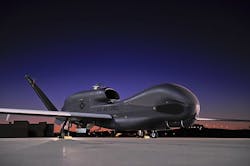Raytheon to upgrade electro-optical surveillance sensor in Global Hawk Block 30 long-range UAV
WRIGHT-PATTERSON AFB, Ohio – U.S. Air Force surveillance and reconnaissance experts are asking the Raytheon Co. to upgrade an electro-optical sensor suite in the RQ-4 Global Hawk long-range unmanned aerial vehicle (UAV).
Officials of the Air Force Lifecycle Management Center at Wright-Patterson Air Force Base, Ohio, announced a $25.9 million contract Friday to the Raytheon Space and Airborne Systems segment in El Segundo, Calif., for the Global Hawk Block 30 Enhanced Integrated Sensor Suite (EISS) modification and for the Enhanced Electro-Optical Receiver Unit (EERU) retrofit.
The EISS provides reconnaissance imagery using an all-weather synthetic aperture radar and moving target indicator (SAR/MTI), a high-resolution electro-optical (EO) digital camera, and a third-generation infrared (IR) sensor, all operating through a common signal processor.
The Raytheon EISS enables the Global Hawk to survey vast geographic regions with image quality that can distinguish various types of vehicles, aircraft, people, and missiles, during the day, at night, and in bad weather.
The EISS transmits imagery and position information from altitudes as high as 60,000 feet with near real-time speed with night vision and radar detection capabilities.
The EERU is one of several line-replaceable units inside the EISS. To modify the EERU, Raytheon engineers also must modify hardware and software in the EISS's Enhanced Sensor Electronics Unit (ESEU) and Enhanced Integrated Sensor Processor (EISP).
Air Force leaders seek to demonstrate these upgrades to the Global Hawk Block 30's EISS, and then upgrade the service's entire Global Hawk Block 30 fleet with these enhancements.
The Global Hawk Block 30 is 47.6 feet long, has a wingspan of 130.9 feet, can fly as high as 60,000 feet, can carry payloads as heavy as 3,000 pounds, and can fly for as long as 32 hours on one load of fuel.
On this contract Raytheon will do the work in El Segundo, Calif., and should be finished by February 2019. For more information contact Raytheon Space and Airborne Systems online at www.raytheon.com/capabilities/sensors, or the Air Force Lifecycle Management Center at www.wpafb.af.mil/aflcmc.
Learn more: search the Aerospace & Defense Buyer's Guide for companies, new products, press releases, and videos

